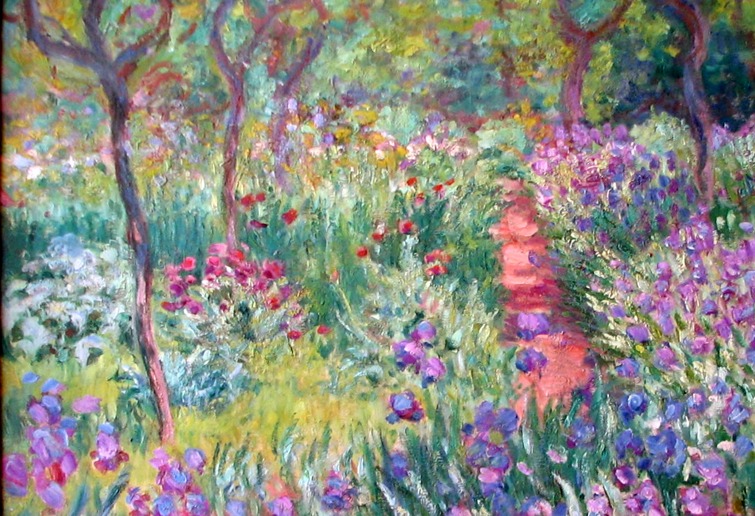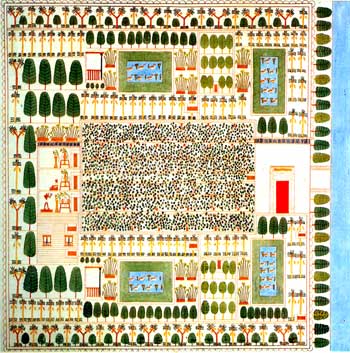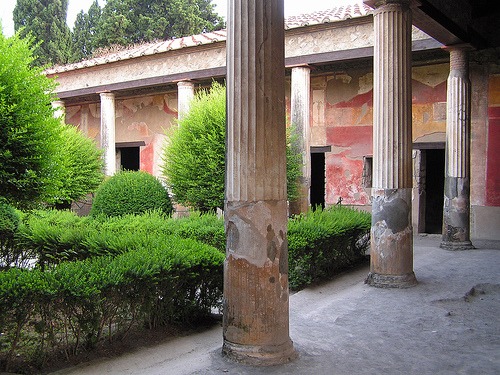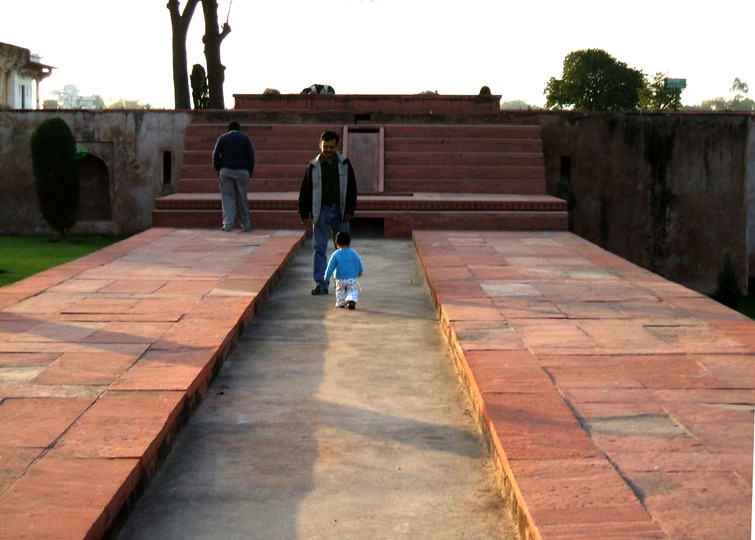 Christine’s question about the influence of French Impressionist painting on the art of garden design has set me thinking. Since writing an essay about Gertrude Jekyll, at college in 1969, I have argued that the painter who most influenced Gertrude Jekyll’s style of planting design was J M W Turner. I still think this is correct but the following comment from Colour Schemes for the Flower Garden has been extremely influential. Jekyll wrote that planting design is ‘like having a box of paints from the best colourman, or, to go one step further, it is like having portions of these paints set out upon a palette.’ Once you start thinking about plants as ‘a palette’ of colours, you are on the high road to English Impressionist Planting Design. Monet’s own garden at Giverny was not planted impressionistically but his paintings of the garden are in an impressionist style and, curiously, photographs of the Water Lily Pond at Giverny also have an impressionist character.
Christine’s question about the influence of French Impressionist painting on the art of garden design has set me thinking. Since writing an essay about Gertrude Jekyll, at college in 1969, I have argued that the painter who most influenced Gertrude Jekyll’s style of planting design was J M W Turner. I still think this is correct but the following comment from Colour Schemes for the Flower Garden has been extremely influential. Jekyll wrote that planting design is ‘like having a box of paints from the best colourman, or, to go one step further, it is like having portions of these paints set out upon a palette.’ Once you start thinking about plants as ‘a palette’ of colours, you are on the high road to English Impressionist Planting Design. Monet’s own garden at Giverny was not planted impressionistically but his paintings of the garden are in an impressionist style and, curiously, photographs of the Water Lily Pond at Giverny also have an impressionist character.
Category Archives: garden history
Indian water gardens history and restoration
On the evidence of the Ramayana and the Mahabharata (see quotes below), Ancient India had the most fabulous gardens. But they were lost and the Indian gardens we know today were made by, or influenced by, Islam. Various acts of violence have made Muslims unpopular in India and this may have contributed to the comparative neglect of India’s gardens – despite India having the world’s finest examples of Islamic gardens. So what can be done to revive and restore this wonderful heritage? One of the great tasks is to get the water back into the canals, as in the gardens of the Taj Mahal and Humayun’s Tomb. But how can this be done? The task requires local enterprise. Garden managers should be informed that pools, baolies, canals and plants require water. An Indian Decade of Water Gardens should be declared during which local garden curators and their malis can raise entrance fees on days when the water systems are working and share the increased revenue with staff. The present system of charging foreign visitors 10 times as much as Indian visitors should be replaced with a system of charging higher entrance fees to all non-local visitors. India now has as a middle class equal in size and wealth to a large European country, providing a resource which should be ‘tapped’ to fund the restoration of India’s water gardens. When things start getting better they are likely to continue getting better. The Ram Bagh Gardens were made by Babur, the first Mughal Emperor, but are now named after Lord Rama, hero of the Ramayana (image courtesy ruchir75). [Notes (1) a mali is a gardener (2) it costs more to enter Versailles when the fountains are working]
Ramayana on gardens
Beyond the sea my Lanka stands
Filled with fierce forms and giant bands,
A glorious city fair to see
As Indra’s Amaravati.
A towering height of solid wall,
Flashing afar, surrounds it all,
Its golden courts enchant the sight,
And gates aglow with lazulite.
Steeds, elephants, and cars are there,
And drums’ loud music fills the air,
Fair trees in lovely gardens grow
Whose boughs with varied fruitage glow.
Mahabharata on gardens
Within that palace Maya placed a peerless tank, and in that tank were lotuses with leaves of dark-coloured gems and stalks of bright jewels, and other flowers also of golden leaves. And aquatic fowls of various species sported on its bosom. Itself variegated with full-blown lotuses and stocked with fishes and tortoises of golden hue, its bottom was without mud and its water transparent. There was a flight of crystal stairs leading from the banks to the edge of the water. The gentle breezes that swept along its bosom softly shook the flowers that studded it. The banks of that tank were overlaid with slabs of costly marble set with pearls. And beholding that tank thus adorned all around with jewels and precious stones, many kings that came there mistook it for land and fell into it with eyes open. Many tall trees of various kinds were planted all around the palace. Of green foliage and cool shade, and ever blossoming, they were all very charming to behold. Artificial woods were laid around, always emitting a delicious fragrance. And there were many tanks also that were adorned with swans and Karandavas and Chakravakas (Brahminy ducks) in the grounds lying about the mansion. And the breeze bearing the fragrance of lotuses growing in water and (of those growing on land) ministered unto the pleasure and happiness of the Pandavas. And Maya having constructed such a palatial hall within fourteen months, reported its completion unto Yudhishthira.
Re-creation of the world's oldest garden design in Egypt

The plan of Sennufer's Garden is the most famous illustration of an Egyptian garden, and the world's oldest accurate plan of a garden
I heard a rumor that Sennufer’s Garden is to be re-created. This is a project I have dreamed of (see note at foot of page on The Domain of Amun) and I believe it is the best tourism investment Egypt could make.
– the project will attract worldwide publicity
– the re-created garden will remind the world that Egypt may well be the country in which the world’s first pleasure garden was made (see blog post Where is the world’s oldest garden?)
– garden visiting is an extremely popular tourist activity, with the Alhambra said to be the most visited garden in Europe
– a new tourist attraction on the East bank in Luxor will take some of the pressure off the ancient monuments on the West bank of the Nile
– a re-created historic garden will fit well with the ambience of the resort hotels being developed on the East bank
I do not know if it has been arranged but the re-created garden is the type of project which could easily attract funding from a hotel chain, an Arab billionaire or from the Aga Khan Historic Cities Support Programme (HCSP) . Since the garden structures would be of mud brick, the cost would not be exorbitant.
The new Sennufer’s garden will be an invaluable contribution to the world’s cultural heritage. If he has a hand in the project, congratulations to Dr. Zahi Hawass (Secretary General, The Supreme Council of Antiquities). A re-creation of the world’s oldest garden would be a wonderful event.
Other Egyptian garden plans survive but Sennufer’s Garden Plan is by far the most sophisticated and in some respects astonishingly modern. See Marie-Luise Gothein’s explanation of the plan of Sennefer’s garden.
[See also: Previous post on Asian gardens and landscapes]
Where was the world's first garden made?

The garden of the House of Venus at Pompeii is one of the oldest surviving gardens in the world (image courtesy John Keogh)
Cultivation and the domestication of plants began in the Levantine Corridor, which runs from Dead Sea to the Damascus Basin, and quite probably outside Jericho. This is known because the earliest domesticated plants are all native to this region and radio-carbon dating reveals that horticultural activity began c9,000 BCE. Plants were cultivated by hand and with digging sticks, not with the plough, but the plants cultivated were all cereals and pulses, making ‘farming’ a better description of the activity than ‘gardening’ or ‘horticulture’ in the modern sense of ‘not ploughed’.
The first literary evidence of gardening comes from Sumer in Lower Mesopotamia. Gilgamesh mentions that his city (Uruk) was ‘one third gardens’ – but the gardens were were palm orchards. Some flowers may have been grown but the main purpose was growing food and the gardens are unlikely to have been beside houses. People lived on dry mounds (tells) and required irrigation to grow fruit and vegetables. The Garden of Eden was ‘located’ in Sumer but its status is mythological rather than historical.
China is another candidate for having made the first gardens but the only places we know of were more like National Parks than anything we would call a garden. Chinese imperial parks were fast tracts of wild landscape set aside for hunting, as at Changan. There were altars in the parks, and pavilions at a later date, and crops were cultivated but they are better described as parks than as ‘gardens’.
The next candidate country for having had the ‘world’s first garden’ is Egypt and since the Egyptians had gardens in the exact sense in which the word is now used, ‘Egypt’ is the best answer to the question ‘Where was the world’s first garden made?’ Some temple gardens (sanctuaries, like Karnak) survive in Egypt but the only representations of domestic gardens are paintings and models. The oldest garden layout known to archaeology may be at Passargadae in Iran.
So where was Europe’s first garden made? The possibilities are Crete, mainland Greece, Sicily and mainland Italy. The inhabitants of Greece (who did not speak Greek) were cultivators by 7000 BCE, which is 2000 years before the Egyptians, and practiced ornamental horticulture in classical times (500 BCE). But Europe’s first gardens in the modern sense of enclosed and planted spaces designed in conjunction with dwellings were probably in Italy – and the oldest surviving examples are certainly in Pompeii (above image courtesy John Keogh) with some of them made by Greek-speaking people.
[See also: Previous post on Asian gardens and landscapes]
The world's first historic gardening experiment
Shukallituda is the first gardener known to history, because the world’s oldest literary texts come from Sumer. It is recorded that the raging winds smote his face with the dust of mountains and all the plants he had tended turned desolate. Shukallituda therefore lifted his eyes to the heavens, studied the omens, observed and learned the divine laws of nature. Having acquired new wisdom, he planted the Sarbatu tree in his garden. It gives a broad shade which lasts from sunrise to sunset. As a result of this horticultural experiment, Shukallituda’s garden blossomed forth with all kinds of green plants. The Illustration (Microsoft® Encarta®) shows a ziggurat seen across the Euphrates. The trees look like date palms, which were probably the most widely grown trees in Mesopotamian gardens. The area beneath the palms conveys something of the character of a Sumerian garden in the time of Gilgamesh. He was the fifth king of Uruk, ruling c2700 BCE, and boasted that his city was ‘one third gardens’ – by which he probably meant date and orchard gardens within the city wall. This part of Iraq is now completely arid, which is a blessing for archaeologists…. ‘ a landscape from which came some of the earliest and most important impulses leading to Mesopotamian civilization, a landscape dotted with urban ruins testifying to past intensive settlement, prosperity, and even greatness, today is virtually empty and wholly neglected’ (The Uruk Countryside Univ Chicago 1972, p.1)
[See also: Previous post on Asian gardens and landscapes]
History of Asian garden and landscape design book

Himalayas by Ilker Ender
Phew!
My ‘Tomfool Project’ to write a history of Asian gardens and landscape architecture is done: I have just posted the CS (computer-script) to the publisher. The main subjects are Ancient Garden Design, Islamic Garden Design, Indian Garden Design, Chinese Garden Design, Japanese Garden Design and modern landscape architecture across Asia. The text files, drawings and photographs fit on one DVD, so all I have done is re-arrange some binary code, unless you count taking over 100,000 photographs. The easier-to-write chapters drew on other work but the difficult chapters took a year each for research and travel. The sensible alternatives would have been not to have begun the project or to have started 40 years earlier by learning half a dozen Asian languages. But I enjoyed the work and will be a lucky man if the ‘royalties’ pay for the travel – so you could say the books will be sold at ‘cost price minus’. It reminds me of the advice I received from Arnold Weddle about 30 years ago. We were making use of adjoining urinals at the time and I think the conversation went like this:
‘Hi Tom, how are you and what are you doing’. Ignoring the obvious, I replied ‘Fine – I’m writing a book, actually it’s about Landscape planning‘. Arnold, who had recently founded the journal Urban and landscape planning, replied: ‘Hmmm. Don’t expect to make any money by writing books’
Weddle was a wise man and I often quote another of his remarks. In Techniques of landscape architecture he wrote that the landscape profession is distinguished from its related professions by looking beyond their ‘closely drawn technical limits’ and ‘narrowly drawn territorial boundaries’. Though not quite what he had in mind, I have taken his advice in Asian gardens by relating garden design to the religions, mountains, forests, deserts, social customs, art and architecture of Asia. As you can imagine, this has involved a number of topics in which I might wish to have more expertise. Ananda Coomaraswamy would have been a good man for the job, helped by one of his photographer wives and his ability to think in English, Hindi, Greek, Latin, Sanskrit, Pali, Persian and Chinese.
[See also: next post on Asian gardens and landscapes]


